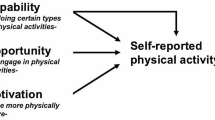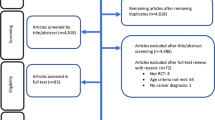Abstract
Purpose
Chronic health conditions and impaired quality of life are commonly experienced in childhood cancer survivors. While rehabilitation clinics support patients in coping with the disease, studies evaluating an inpatient rehabilitation program on promoting physical activity (PA) and health-related quality of life (HRQoL) are missing.
Methods
A 4-week inpatient rehabilitation program was prospectively evaluated. One hundred fifty patients with leukemia or lymphoma (N = 86), brain tumors (N = 38), and sarcomas (N = 26) were enrolled on average 17 months after cessation of acute medical treatment. PA amount and cadence (indicating the intensity of walking activity) using the StepWatch™ 3 Activity Monitor and HRQoL global and physical well-being scores using the KINDL® questionnaire were assessed before, immediately after, and 6 and 12 months following the program and analyzed using multiple linear mixed models.
Results
Significant effects on PA were only found at 12-month follow-up for amount and cadence variables (all p < 0.05). While leukemia and lymphoma patients revealed the highest PA level throughout the study, rehabilitation effects were more pronounced for cadence variables in brain tumor and sarcoma patients. The rehabilitation program had immediate (t = 4.56, p < 0.001) and sustainable effects on HRQoL global scores (6-month follow-up, t = 4.08, p < 0.001; 12-month follow-up, t = 3.13, p < 0.006).
Conclusions
Immediate and sustainable increases in HRQoL indicate that a 4-week rehabilitation program is beneficial for improving psychosocial well-being, while the significant increase in PA levels could be related to general recovery as well. The lack of a control group hampers the evaluation of the rehabilitation program on promoting PA levels in pediatric cancer patients.



Similar content being viewed by others
References
Rossig C, Juergens H, Schrappe M, Moericke A, Henze G, von Stackelberg A, Reinhardt D, Burkhardt B, Woessmann W, Zimmermann M, Gadner H, Mann G, Schellong G, Mauz-Koerholz C, Dirksen U, Bielack S, Berthold F, Graf N, Rutkowski S, Calaminus G, Kaatsch P, Creutzig U (2013) Effective childhood cancer treatment: the impact of large scale clinical trials in Germany and Austria. Pediatr Blood Cancer 60:1574–1581
Blaauwbroek R, Stant AD, Groenier KH, Kamps WA, Meyboom B, Postma A (2007) Health-related quality of life and adverse late effects in adult (very) long-term childhood cancer survivors. Eur J Cancer 43:122–130
Speechley KN, Barrera M, Shaw AK, Morrison HI, Maunsell E (2006) Health-related quality of life among child and adolescent survivors of childhood cancer. J Clin Oncol 24:2536–2543
KC O, AC M, CA S, Kawashima T, MM H, AT M, DL F, Marina N, Hobbie W, NS K-L, CL S, Leisenring W, LL R, Childhood Cancer Survivor Study (2006) Chronic health conditions in adult survivors of childhood cancer. N Engl J Med 355:1572–1582
Hudson MM, Ness KK, Gurney JG, Mulrooney DA, Chemaitilly W, Krull KR, Green DM, Armstrong GT, Nottage KA, Jones KE, Sklar CA, Srivastava DK, Robison LL (2013) Clinical ascertainment of health outcomes among adults treated for childhood cancer. JAMA 309:2371–2381
Ness KK, Hudson MM, Ginsberg JP, Nagarajan R, Kaste SC, Marina N, Whitton J, Robison LL, Gurney JG (2009) Physical performance limitations in the childhood Cancer survivor study cohort. J Clin Oncol 27:2382–2389
Loprinzi PD, Cardinal BJ, Loprinzi KL, Lee H (2012) Benefits and environmental determinants of physical activity in children and adolescents. Obes Facts 5:597–610
Evenson KR, Mota J (2011) Progress and future directions on physical activity research among youth. J Phys Act Health 8:149–151
Winter C, Muller C, Hoffmann C, Boos J, Rosenbaum D (2010) Physical activity and childhood cancer. Pediatr Blood Cancer 54:501–510
Ness KK, Leisenring WM, Huang S, Hudson MM, Gurney JG, Whelan K, Hobbie WL, Armstrong GT, Robison LL, Oeffinger KC (2009) Predictors of inactive lifestyle among adult survivors of childhood cancer: a report from the childhood Cancer survivor study. Cancer 115:1984–1994
McDougall J, Tsonis M (2009) Quality of life in survivors of childhood cancer: a systematic review of the literature (2001-2008). Support Care Cancer 17:1231–1246
Zebrack BJ, Chesler MA (2002) Quality of life in childhood cancer survivors. Psychooncology 11:132–141
Gotte M, Kesting SV, Winter CC, Rosenbaum D, Boos J (2015) Motor performance in children and adolescents with cancer at the end of acute treatment phase. Eur J Pediatr 174:791–799
Mitchell HR, Lu X, Myers RM, Sung L, Balsamo LM, Carroll WL, Raetz E, Loh ML, Mattano LA, Winick NJ, Devidas M, Hunger SP, Maloney K, Kadan-Lottick NS (2015) Prospective, longitudinal assessment of quality of life in children from diagnosis to three months off treatment for standard risk (SR) acute lymphoblastic leukemia (ALL): results of children’s oncology group study AALL0331. Int J Cancer 138(2):332–339
Penn A, Lowis SP, Hunt LP, Shortman RI, Stevens MC, McCarter RL, Curran AL, Sharples PM (2008) Health related quality of life in the first year after diagnosis in children with brain tumours compared with matched healthy controls; a prospective longitudinal study. Eur J Cancer 44:1243–1252
Hinds PS, Gattuso JS, Billups CA, West NK, Wu J, Rivera C, Quintana J, Villarroel M, Daw NC (2009) Aggressive treatment of non-metastatic osteosarcoma improves health-related quality of life in children and adolescents. Eur J Cancer 45:2007–2014
Braam KI, van der Torre P, Takken T, Veening MA, van Dulmen-den Broeder E, Kaspers GJ (2013) Physical exercise training interventions for children and young adults during and after treatment for childhood cancer. Cochrane Database Syst Rev 4:CD008796
Baumann FT, Bloch W, Beulertz J (2013) Clinical exercise interventions in pediatric oncology: a systematic review. Pediatr Res 74:366–374
Beulertz J, Prokop A, Rustler V, Bloch W, Felsch M, Baumann FT (2015) Effects of a 6-month, group-based, therapeutic exercise program for childhood cancer outpatients on motor performance, level of activity, and quality of life. Pediatr Blood Cancer 63(1):127–132
Wurz A, Chamorro-Vina C, Guilcher GM, Schulte F, Culos-Reed SN (2014) The feasibility and benefits of a 12-week yoga intervention for pediatric cancer out-patients. Pediatr Blood Cancer 61:1828–1834
Welk GJ, Corbin CB, Dale D (2000) Measurement issues in the assessment of physical activity in children. Res Q Exerc Sport 71:S59–S73
McDonald CM, Widman L, Abresch RT, Walsh SA, Walsh DD (2005) Utility of a step activity monitor for the measurement of daily ambulatory activity in children. Arch Phys Med Rehabil 86:793–801
Barreira TV, Katzmarzyk PT, Johnson WD, Tudor-Locke C (2013) Walking cadence and cardiovascular risk in children and adolescents: NHANES, 2005-2006. Am J Prev Med 45:e27–e34
Ravens-Sieberer U, Ellert U, Erhart M (2007) Health-related quality of life of children and adolescents in Germany. Norm data from the German Health Interview and Examination Survey (KiGGS). Bundesgesundheitsblatt Gesundheitsforschung Gesundheitsschutz 50:810–818
Speyer E, Herbinet A, Vuillemin A, Briancon S, Chastagner P (2010) Effect of adapted physical activity sessions in the hospital on health-related quality of life for children with cancer: a cross-over randomized trial. Pediatr Blood Cancer 55:1160–1166
Winter CC, Muller C, Hardes J, Gosheger G, Boos J, Rosenbaum D (2013) The effect of individualized exercise interventions during treatment in pediatric patients with a malignant bone tumor. Support Care Cancer 21:1629–1636
Moyer-Mileur LJ, Ransdell L, Bruggers CS (2009) Fitness of children with standard-risk acute lymphoblastic leukemia during maintenance therapy: response to a home-based exercise and nutrition program. J Pediatr Hematol Oncol 31:259–266
Huang TT, Ness KK (2011) Exercise interventions in children with cancer: a review. Int J Pediatr 2011:461512
Tudor-Locke C, Craig CL, Beets MW, Belton S, Cardon GM, Duncan S, Hatano Y, Lubans DR, Olds TS, Raustorp A, Rowe DA, Spence JC, Tanaka S, Blair SN (2011) How many steps/day are enough? for children and adolescents. Int J Behav Nutr Phys Act 8:78–5868–8-78
Adams MA, Johnson WD, Tudor-Locke C (2013) Steps/day translation of the moderate-to-vigorous physical activity guideline for children and adolescents. Int J Behav Nutr Phys Act 10:49–5868–10-49
Craig CL, Cameron C, Tudor-Locke C (2013) CANPLAY pedometer normative reference data for 21,271 children and 12,956 adolescents. Med Sci Sports Exerc 45:123–129
Barreira TV, Katzmarzyk PT, Johnson WD, Tudor-Locke C (2012) Cadence patterns and peak cadence in US children and adolescents: NHANES, 2005-2006. Med Sci Sports Exerc 44:1721–1727
Beulertz J, Bloch W, Prokop A, Baumann FT (2013) Specific deficit analyses in motor performance and quality of life of pediatric cancer patients—a cross-sectional pilot study. Pediatr Hematol Oncol 30:336–347
Eiser C (2009) Assessment of health-related quality of life after bone cancer in young people: easier said than done. Eur J Cancer 45:1744–1747
Keats MR, Culos-Reed SN (2008) A community-based physical activity program for adolescents with cancer (project TREK): program feasibility and preliminary findings. J Pediatr Hematol Oncol 30:272–280
Paxton RJ, Jones LW, Rosoff PM, Bonner M, Ater JL, Demark-Wahnefried W (2010) Associations between leisure-time physical activity and health-related quality of life among adolescent and adult survivors of childhood cancers. Psychooncology 19:997–1003
Badr H, Chandra J, Paxton RJ, Ater JL, Urbauer D, Cruz CS, Demark-Wahnefried W (2013) Health-related quality of life, lifestyle behaviors, and intervention preferences of survivors of childhood cancer. J Cancer Surviv 7:523–534
Reilly JJ, Penpraze V, Hislop J, Davies G, Grant S, Paton JY (2008) Objective measurement of physical activity and sedentary behaviour: review with new data. Arch Dis Child 93:614–619
Gabrys L, Thiel C, Tallner A, Wilms B, Muller C, Kahlert D, Jekauc D, Frick F, Schulz H, Sprengler O, Hey S, Kobel S, Vogt L (2015) Accelerometry for measuring physical activity—recommendations on methods 45:1–9
Acknowledgments
We thank the participating patients for their sustained commitment to the study. The help of Andrea Kelter-Klöpping, Pascal Mailand and Kai Lindkamp in recruiting the participants and data acquisition is gratefully acknowledged. This study was funded by Arbeitsgemeinschaft für Krebsbekämpfung (ARGE Krebs NW).
Author information
Authors and Affiliations
Corresponding author
Ethics declarations
The study protocol was generally approved by the local Ethics Committee but under the condition not to recruit a control group. Informed consent was obtained from the patients and their parents or legal guardian.
Conflict of interest
The authors declare that they have no conflict of interest.
Rights and permissions
About this article
Cite this article
Müller, C., Krauth, K.A., Gerß, J. et al. Physical activity and health-related quality of life in pediatric cancer patients following a 4-week inpatient rehabilitation program. Support Care Cancer 24, 3793–3802 (2016). https://doi.org/10.1007/s00520-016-3198-y
Received:
Accepted:
Published:
Issue Date:
DOI: https://doi.org/10.1007/s00520-016-3198-y




